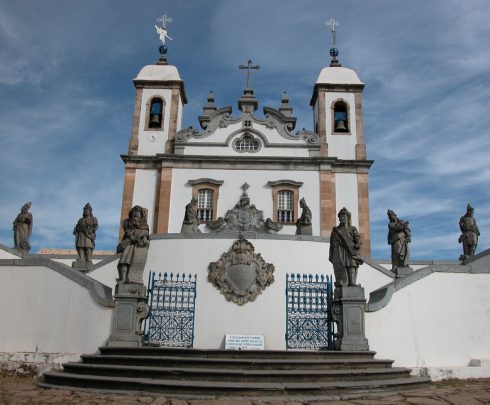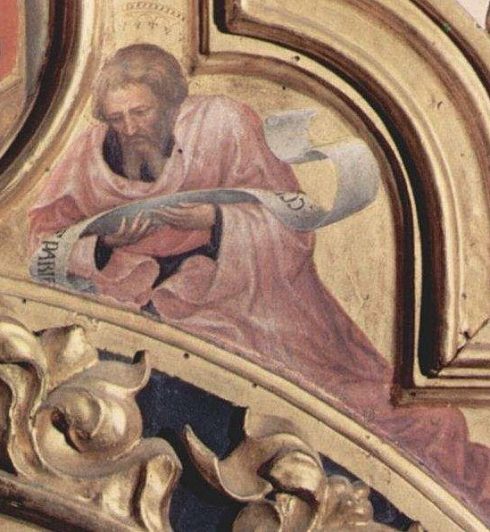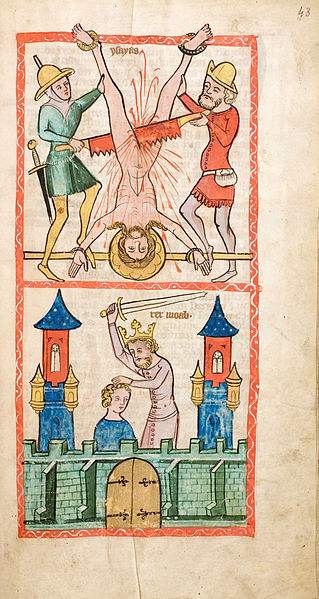From the Prophet himself (i, 1; ii, 1) we learn that he was the son of Amos. Owing to the similarity between Latin and Greek forms of this name and that of the Shepherd-Prophet of Thecue, some Fathers mistook the Prophet Amos for the father of Isaias. St. Jerome in the preface to his “Commentary on Amos” (P.L., XXV, 989) points out this error. Of Isaias’s ancestry we know nothing; but several passages of his prophecies (iii, 1-17, 24; iv, 1; viii, 2; xxxi, 16) lead us to believe that he belonged to one of the best families of Jerusalem. A Jewish tradition recorded in the Talmud (Tr. Megilla, 10b.) held him to be a nephew of King Amasias. As to the exact time of the Prophet’s birth we lack definite data; yet he is believed to have been about twenty years of age when he began his public ministry. He was a citizen, perhaps a native, of Jerusalem. His writings give unmistakable signs of high culture. From his prophecies (vii and viii) we learn that he married a woman whom he styles “the prophetess” and that he had two sons, She`arYashub and Mahershalalhashbaz. Nothing whatever indicates that he was twice married as some fancy on the gratuitous and indefensible supposition that the `almah of vii, 14, was his wife.

Eight of the twelve Prophets sculpted by Aleijadinho in front of the church of the sanctuary of Bom Jesus of Matosinhos at Congonhas, Brazil. Isaiah is the first statue on the left on the pillar at the beginning of the steps.
The prophetical ministry of Isaias lasted wellnigh half a century, from the closing year of Ozias, King of Juda, possibly up to that of Manasses. This period was one of great prophetical activity. Israel and Juda indeed were in sore need of guidance. After the death of Jeroboam II revolution followed upon revolution and the northern kingdom had sunk rapidly into an abject vassalage to the Assyrians. The petty nations of the West, however, recovering from the severe blows received in the beginning of the eighth century, were again manifesting aspirations of independence. Soon Theglathphalasar III marched his armies towards Syria; heavy tributes were levied and utter ruin threatened on those who would show any hesitation to pay. In 725 Osee, the last King of Samaria, fell miserably under the onslaught of Salmanasar IV, and three years later Samaria succumbed to the hands of the Assyrians. In the meantime the Kingdom of Juda hardly fared better. A long period of peace had enervated characters, and the young, inexperienced, and unprincipled Achaz was no match for the SyroIsraelite coalition which confronted him. Panicstricken he, in spite of the remonstrances of Isaias, resolved to appeal to Theglathphalasar. The help of Assyria was secured, but the independence of Juda was thereby practically forfeited. In order to explain clearly the political situation to which so many allusions are made in Isaias’s writings there is here subjoined a brief chronological sketch of the period: 745, Theglathphalasar III, king of Assyria; Azarias (A. V. Uzziah), of Juda; Manahem (A. V. Menahem) of Samaria; and Sua of Egypt; 740, death of Azarias; Joatham (A. V. Jotham), king of Juda; capture of Arphad (A. V. Arpad) by Theglathphalasar III (Is., x, 9); 738, campaign of Theglathphalasar against Syria; capture of Calano (A. V. Calno) and Emath (A. V. Hamath); heavy tribute imposed upon Manahem (IV Kings, xv, 19-20); victorious wars of Joatham against the Ammonites (II Par., xxvii, 4-6); 736, Manahem succeeded by Phaceia (A. V. Pekahiah); 735, Joatham succeeded by Achaz (IV Kings, xvi, 1); Phaceia replaced by Phacee (A. V. Pekah), son of Remelia (A. V. Remaliah), one of his captains; Jerusalem besieged by Phacee in alliance with Rasin (A. V. Rezin), king of Syria (IV Kings xvi, 5; Is., vii, 1, 2); 734, Theglathphalasar, replying to Achaz’ request for aid, marches against Syria and Israel, takes several cities of North and East Israel (IV Kings, xv, 29), and banishes their inhabitants; the Assyrian allies devastate part of the territory of Juda and Jerusalem; Phacee slain during a revolution in Samaria and succeeded by Osee (A. V. Hoshea); 733, unsuccessful expeditions of Achaz against Edom (II Par., xxviii, 17) and the Philistines (20); 732, campaign of Theglathphalasar against Damascus; Rasin besieged in his capital, captured, and slain; Achaz goes to Damascus to pay homage to the Assyrian ruler (IV Kings, xvi, 10-19); 727, death of Achaz; accession of Ezechias (IV Kings, xviii, 1); in Assyria Salmanasar IV succeeds Theglathphalasar III, 726, campaign of Salmanasar against Osee (IV Kings, xvii, 3); 725,
Osee makes alliance with Sua, king of Egypt (IV Kings, xvii, 4); second campaign of Salmanasar IV, resulting in the capture and deportation of Osee (IV Kings, xvii, 4); beginning of the siege of Samaria; 722, Sargon succeeds Salmanasar IV in Assyria; capture of Samaria by Sargon; 720, defeat of Egyptian army at Raphia by Sargon; 717, Charcamis, the Hittite stronghold on the Euphrates, falls into the hands of Sargon (Is, x, 8); 713, sickness of Ezechias (IV Kings, xx, 1-11; Is, xxxviii); embassy from Merodach Baladan to Ezechias (IV Kings, xx, 12-13; Is., xxxix); 711, invasion of Western Palestine by Sargon; siege and capture of Azotus (A. V. Ashdod; Is., xx); 709, Sargon defeats Merodach Baladan, seizes Babylon, and assumes title of king of Babylon; 705, death of Sargon; accession of Sennacherib; 701, expedition of Sennacherib against Egypt; defeat of latter at Elteqeh; capture of Accaron (A. V. Ekron); siege of Lachis; Ezechias’s embasy; the conditions laid down by Sennacherib being found too hard the king of Juda prepares to resist the Assyrians; destruction of part of the Assyrian army; hurried retreat of the rest (IV Kings, xviii; Is., xxxvi, xxxvii); 698, Ezechias is succeeded by his son Manasses. The wars of the ninth century and the peaceful security following them produced their effects in the latter part of the next century. Cities sprang up; new pursuits, although affording opportunities of easy wealth, brought about also an increase of poverty. The contrast between class and class became daily more marked, and the poor were oppressed by the rich with the connivance of the judges. A social state founded on iniquity is doomed. But as Israel’s social corruption was greater than Juda’s, Israel was expected to succumb first. Greater likewise was her religious corruption. Not only did idolatrous worship prevail there to the end, but we know from Osee what gross abuses and shameful practices obtained in Samaria and throughout the kingdom, whereas the religion of the people of Juda on the whole seems to have been a little better. We know, however, as regards these, that at the very time of Isaias certain forms of idolatrous worship, like that of Nohestan and of Moloch, probably that also of Tammur and of the “host of heaven”, were going on in the open or in secret.
Commentators are at variance as to when Isaias was called to the prophetical office. Some think that previous to the vision related in vi, 1, he had received communications from heaven. St. Jerome in his commentary on the passage holds that chapters i-v ought to be attributed to the last years of King Ozias, then ch. vi would commence a new series begun in the year of the death of that prince (740 B.C.; P.L., XXIV, 91; cf. St. Gregory Nazianzen, Orat. ix; P.G., XXXV, 820). It is more commonly held, however, that ch. vi refers to the first calling of the Prophet; St. Jerome himself, in a letter to Pope Damasus seems to adopt this view (P. L., XXII, 371; cf. Hesychius “In Is.”, P.G. XCIII, 1372), and St. John Chrysostom, commenting upon Is., vi, 5, very aptly contrasts the promptness of the Prophet with the tergiversations of Moses and Jeremias. On the other hand, since no prophecies appear to be later than 701 B.C., it is doubtful if Isaias saw the reign of Manasses at all; still a very old and widespread tradition, echoed by the Mishna  (Tr. Yebamoth, 49b; cf. Sanhedr., 103b), has it that the Prophet survived Ezechias and was slain in the persecution of Manasses (IV Kings, xxi, 16). This prince had him convicted of blasphemy, because he had dared say: “I saw the Lord sitting upon a throne” (vi, 1), a pretension in conflict with God’s own assertion in Exod., xxxiii, 20: “Man shall not see me and live”. He was accused, moreover, of having predicted the ruin of Jerusalem and called the holy city and the people of Juda by the accursed names of Sodom and Gomorrah. According to the “Ascension of Isaias”, the Prophet’s martyrdom consisted in being sawed asunder. Tradition shows this to have been unhesitatingly believed. The Targum on IV Kings, xxi, 6, admits it; it is preserved in two treatises of the Talmud (Yebamoth, 49b; Sanhedr., 103b); St. Justin (Dial. c. Tryph., cxx), and many of the Fathers adopted it, taking as unmistakable allusions to Isaias those words of the Heb., xi, 37, “they (the ancients) were cut asunder” (cf. Tertullian, “De patient.”, xiv; P.L., I, 1270; Orig., “In Is., Hom.” I, 5, P.G., XIII, 223; “In Matt.”, x, 18, P.G., XIII, 882; “In Matt.”, Ser. 28, P.G., XIII, 1637; “Epist. ad Jul. Afr.”, ix, P.G., XI, 65; St. Jerome, “In Is.”, lvii, 1, P.L., XXIV, 546-548; etc.). However, little trust should be put in the strange details mentioned in the “De Vit. Prophet.” of pseudoEpiphanius (P.G., XLIII, 397, 419). The date of the Prophet’s demise is not known. The Roman Martyrology commemorates Isaias on 6 July. His tomb is believed to have been in Paneas in Northern Palestine, whence his relics were taken to Constantinople in A.D. 442.
(Tr. Yebamoth, 49b; cf. Sanhedr., 103b), has it that the Prophet survived Ezechias and was slain in the persecution of Manasses (IV Kings, xxi, 16). This prince had him convicted of blasphemy, because he had dared say: “I saw the Lord sitting upon a throne” (vi, 1), a pretension in conflict with God’s own assertion in Exod., xxxiii, 20: “Man shall not see me and live”. He was accused, moreover, of having predicted the ruin of Jerusalem and called the holy city and the people of Juda by the accursed names of Sodom and Gomorrah. According to the “Ascension of Isaias”, the Prophet’s martyrdom consisted in being sawed asunder. Tradition shows this to have been unhesitatingly believed. The Targum on IV Kings, xxi, 6, admits it; it is preserved in two treatises of the Talmud (Yebamoth, 49b; Sanhedr., 103b); St. Justin (Dial. c. Tryph., cxx), and many of the Fathers adopted it, taking as unmistakable allusions to Isaias those words of the Heb., xi, 37, “they (the ancients) were cut asunder” (cf. Tertullian, “De patient.”, xiv; P.L., I, 1270; Orig., “In Is., Hom.” I, 5, P.G., XIII, 223; “In Matt.”, x, 18, P.G., XIII, 882; “In Matt.”, Ser. 28, P.G., XIII, 1637; “Epist. ad Jul. Afr.”, ix, P.G., XI, 65; St. Jerome, “In Is.”, lvii, 1, P.L., XXIV, 546-548; etc.). However, little trust should be put in the strange details mentioned in the “De Vit. Prophet.” of pseudoEpiphanius (P.G., XLIII, 397, 419). The date of the Prophet’s demise is not known. The Roman Martyrology commemorates Isaias on 6 July. His tomb is believed to have been in Paneas in Northern Palestine, whence his relics were taken to Constantinople in A.D. 442.
The literary activity of Isaias is attested by the canonical book which bears his name; moreover allusion is made in II Par., xxvi, 22, to “Acts of Ozias first and last . . . written by Isaias, the son of Amos, the prophet”. Another passage of the same book informs us that “the rest of the acts of Ezechias and his mercies, are written in the Vision of Isaias, son of Amos, the prophet”, in the Book of the Kings of Juda and Israel. Such at least is the reading of the Massoretic Bible, but its text here, if we may judge from the variants of the Greek and St. Jerome, is somewhat corrupt. Most commentators who believe the passage to be authentic think that the writer refers to Is., xxxvi-xxxix. We must finally mention the “Ascension of Isaias”, at one time attributed to the Prophet, but never admitted into the Canon.
(cfr. Catholic Encyclopedia)












